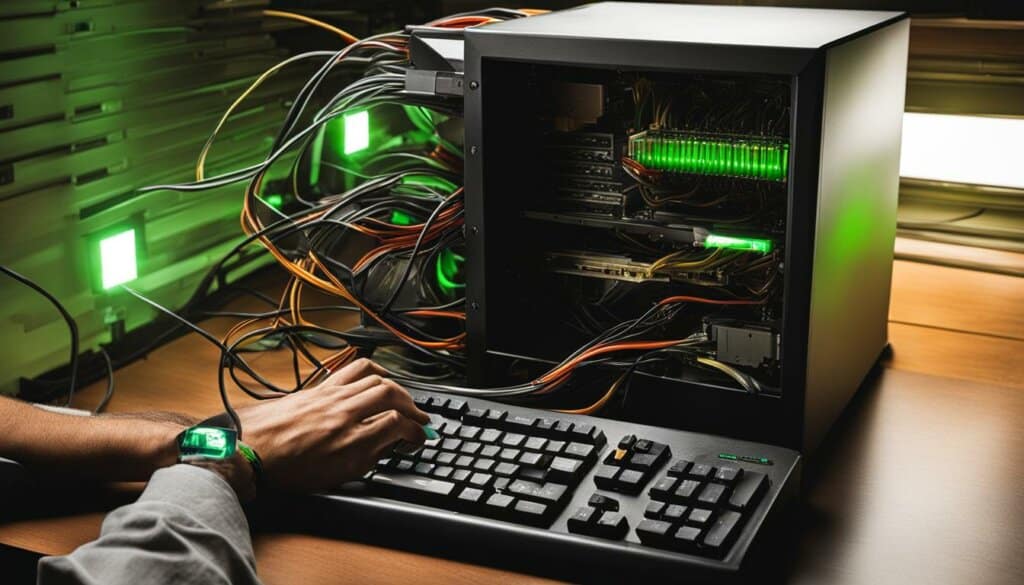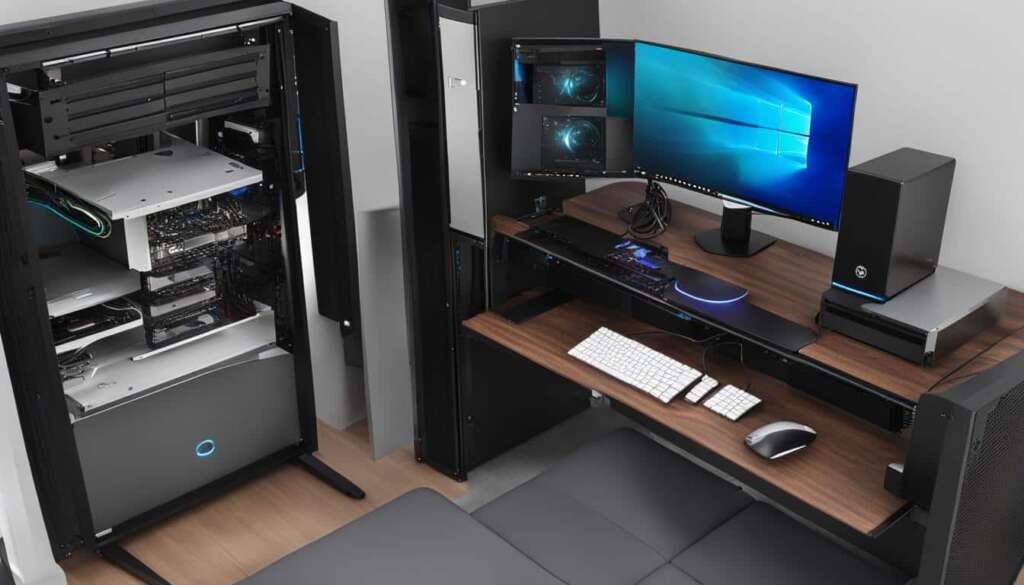Table of Contents
Are you looking for a cost-effective way to unleash the potential of your old PC? Look no further! With our step-by-step guide, you can set up a powerful web hosting server on your own computer. Say goodbye to recurring hosting fees and gain full control over your website’s security and performance. In this article, we will show you how to transform your old desktop into the best hosting server for PC.
By repurposing your old computer, you can create a personalized and secure web hosting solution. With the right software and setup, your PC can host websites, blogs, and other online projects. Whether you’re a small business owner, a hobbyist, or a tech enthusiast, building a hosting server on your PC is a cost-effective and empowering choice.
In the following sections, we will provide detailed instructions on how to:
- Prepare your computer for hosting server setup
- Install the operating system
- Configure a user-friendly GUI control
- Set up port forwarding for external access
- Obtain a free domain name for your server
- Test your website to ensure it’s working correctly
- Manage permissions for website updates
- Consider other factors and options for PC hosting servers
- Evaluate the pros and cons of free DIY hosting
- Implement essential security measures
Stay tuned for an exciting journey into the world of DIY hosting servers and discover the endless possibilities of repurposing your old PC!
Preparing the Computer for Hosting Server Setup
Before diving into the exciting realm of setting up your own hosting server on a PC, it is crucial to ensure that your computer is ready for the task. The first step is to check if your computer meets the necessary requirements to function as a hosting server. The requirements include having at least 64MB of RAM, an Intel or AMD processor, a CD-ROM drive, at least 600MB of disk space (although more is recommended for a server), the ability to boot from a CD, and an Ethernet port. These requirements are easily achievable, and even if your computer falls short of high-end specifications, it can still be utilized as a hosting server with the right server edition software.
Once you have confirmed that your computer meets the basic requirements, the next step is to choose the right hosting server software. There are several options available, each with its own set of features and compatibility. Some popular hosting server software for PCs include XAMPP, WampServer, and EasyPHP. These software packages provide a comprehensive platform for hosting websites, databases, and web applications on your PC-based hosting server. It is important to choose the software that best suits your needs and technical expertise.
After selecting the hosting server software, you can proceed with the installation process. This typically involves downloading the software package from the official website, running the installer, and following the on-screen instructions. Once installed, you will have access to a powerful suite of tools and features that will enable you to configure and manage your hosting server effectively. It is recommended to refer to the software’s documentation or online tutorials for detailed installation instructions and additional guidance.
| Software | Features | Compatibility |
|---|---|---|
| XAMPP | Apache, MySQL, PHP, Perl | Windows, macOS, Linux |
| WampServer | Apache, MySQL, PHP, phpMyAdmin | Windows |
| EasyPHP | Apache, MySQL, PHP, phpMyAdmin | Windows |
Key Features of Hosting Server Software:
- Apache: Powerful and widely-used web server software.
- MySQL: Robust and reliable database management system.
- PHP: Versatile programming language for dynamic web development.
- Perl: Comprehensive scripting language for various purposes.
- phpMyAdmin: Web-based graphical interface for MySQL database management.
“Setting up a hosting server on your PC opens up a world of possibilities. With the right preparations and software, you can transform your old computer into a versatile and efficient hosting solution. Take the time to ensure that your hardware meets the necessary requirements, choose the software that suits your needs, and follow the installation instructions carefully. Soon enough, you’ll have your very own PC-based hosting server up and running, ready to bring your websites and online projects to life.”
Installing the Operating System
To set up a hosting server on your PC, you will need to install a server edition operating system. One popular option is Ubuntu Server Edition, which is a lightweight and efficient operating system specifically designed for server applications. You can download the Ubuntu Server Edition CD image from the official website and burn it to a disc or use an image burning software to create a bootable USB drive. The installation process is straightforward and will automatically detect and configure your network settings.
After you have prepared your installation media, insert the CD or connect the USB drive to your PC and restart the computer. Make sure that your PC is set to boot from the installation media in the BIOS settings. Once the Ubuntu Server Edition installation begins, follow the on-screen instructions to choose your language, time zone, keyboard layout, and disk partitioning. You can select the default options for most settings or customize them according to your preferences.
During the installation, you will be prompted to create a username and password for the administrator account. It is important to choose a strong password to ensure the security of your hosting server. After completing the installation, the system will reboot, and you will be ready to proceed with the configuration of your hosting server.
Installing Webmin for GUI Control
When setting up a hosting server on a PC, it’s important to have a user-friendly interface for managing server settings and services. One popular tool for this purpose is Webmin, a web-based graphical user interface (GUI) that provides an intuitive way to control your hosting server.
Webmin allows you to easily configure various aspects of your hosting server, such as network settings, user accounts, and file management. With its user-friendly interface, even users without extensive technical knowledge can navigate and customize their server settings.
“Webmin is a game-changer for those setting up a hosting server on a PC. Its web-based GUI makes it incredibly easy to manage your server, even if you’re not a tech pro.” – Web Hosting Enthusiast
To install Webmin, you can follow these steps:
- Access your hosting server’s terminal or command line interface.
- Update your system’s package repository to ensure you have the latest software packages.
- Execute the command to download and install Webmin. This will automatically fetch the necessary dependencies and configure the software.
- After the installation is complete, you can access Webmin by opening a web browser and entering the server’s IP address followed by the port number specified during installation.
With Webmin installed, you’ll have a user-friendly interface to manage and control your hosting server, making it easier to customize and optimize your server settings. Whether you’re a beginner or an experienced user, Webmin simplifies the process of setting up and managing a hosting server on a PC.
Setting Up Port Forwarding for External Access
One of the crucial steps in setting up a hosting server on a personal computer is configuring port forwarding for external access. Port forwarding allows incoming traffic on specific ports to be redirected to your hosting server, making your website accessible to the public. By forwarding commonly used ports like HTTP (port 80), FTP (port 21), and SSH (port 22), you can ensure that visitors can easily access your website.
The process of setting up port forwarding may vary depending on your router model, but it generally involves accessing your router’s administration page and configuring the necessary settings. You will need to navigate to the port forwarding section and create entries for the relevant ports and your hosting server’s IP address. This will enable the router to redirect incoming requests to your server, allowing users to access your website from anywhere on the internet.
To find out the specific steps for your router model, you can refer to the user manual or search for online tutorials that provide guidance on port forwarding. It’s important to note that different router manufacturers may have slightly different interfaces and terminologies, but the general concept remains the same. Once you have completed the port forwarding setup, your hosting server should be accessible to the public, allowing you to share your website with the world.
Table: Commonly Used Ports for Hosting Servers
| Service | Port Number |
|---|---|
| HTTP (Hypertext Transfer Protocol) | 80 |
| HTTPS (Secure HTTP) | 443 |
| FTP (File Transfer Protocol) | 21 |
| SSH (Secure Shell) | 22 |
| SMTP (Simple Mail Transfer Protocol) | 25 |

“Setting up port forwarding is a crucial step in making your website accessible from anywhere on the internet.”
Obtaining a Free Domain Name
When setting up a hosting server on your PC, one important step is to obtain a free domain name for your website. Having a custom domain name not only makes it easier for users to remember and access your site but also gives it a more professional and polished appearance.
One popular option for obtaining a free domain name is the website no-ip.com. This platform allows you to create a domain name based on your internet IP address. By signing up for an account and following the on-screen instructions, you can set up a custom domain name for your hosting server.
With a free domain name, you can create a unique online identity for your website, making it stand out and attracting more visitors. It adds credibility and trustworthiness to your site, especially if you’re running a business or offering professional services.

Benefits of a Free Domain Name
- Professional appearance: A custom domain name gives your website a professional and established look.
- Improved branding: By having a unique domain name, you can reinforce your brand identity and make it more memorable.
- Easy accessibility: A domain name is easier for users to remember and type into their web browsers, increasing the chances of repeat visitors.
- SEO advantages: A domain name with relevant keywords can improve your website’s search engine rankings and visibility.
- Enhanced trustworthiness: A custom domain name enhances the credibility and trustworthiness of your website, especially for online businesses and professional services.
By obtaining a free domain name for your hosting server, you can create a professional and accessible online presence for your website. It’s a simple yet effective way to make your website more memorable, improve brand recognition, and attract more visitors.
Testing Your Website
After setting up your hosting server on your PC and obtaining a domain name, it’s time to test your website to ensure it is functioning correctly. Testing your website is essential to verify that all elements are working as intended and to address any potential issues that may arise. By following a few simple steps, you can make sure your website is ready to go live and provide a seamless experience for your visitors.
Step 1: Enter Your Domain Name or IP Address
To test your website, open a web browser and enter your domain name or IP address in the address bar. This will allow you to check if your website is accessible from the internet. If you have set up port forwarding correctly, your website should load properly, and you will be able to see your website’s content. If you encounter any errors or your website does not load, you may need to troubleshoot your server settings or port forwarding configuration.
Step 2: Check Website Functionality
Once your website loads, navigate through different pages and test all the functionalities, such as links, forms, and interactive elements. This will help you ensure that all aspects of your website are working correctly and that visitors can use your website without any issues. Pay close attention to any error messages or broken links that may indicate problems that need to be addressed.
Step 3: Test on Different Devices and Browsers
It’s important to test your website on various devices and browsers to ensure a consistent experience for all users. Check how your website appears and functions on different screen sizes, such as desktops, laptops, tablets, and smartphones. Additionally, test your website on different browsers, such as Chrome, Firefox, Safari, and Edge, to ensure compatibility across different platforms. This will help you identify any responsive design or compatibility issues and make necessary adjustments.
By thoroughly testing your website, you can ensure that it is fully functional and ready to launch. Address any issues or errors that arise during testing to provide the best possible experience for your website visitors.
Managing Permissions for Website Updates
When it comes to managing and updating your website hosted on a PC hosting server, having the right permissions is crucial. By granting yourself the necessary permissions, you can easily upload and modify website files, ensuring that your website stays up to date with fresh content and updates.
To manage permissions, you can adjust the folder permissions of your website’s root folder. This can be done by executing commands in the terminal to change the ownership and permissions of the folder. By taking ownership of the folder and assigning the appropriate read, write, and execute permissions, you will have the necessary control to make changes to your website.
Additionally, you can use a program like WinSCP to remotely access and manage your server’s files from your main computer. This allows you to easily update your website without needing physical access to the hosting server. With WinSCP, you can navigate the file system, transfer files between your computer and the server, and make changes to your website with just a few clicks.
Example of changing permissions in the terminal:
$ sudo chown -R username:group /path/to/website
$ sudo chmod -R 755 /path/to/website
| Command | Description |
|---|---|
| chown | Changes the ownership of a file or directory |
| -R | Recursively applies the command to all files and directories within the specified path |
| username:group | Sets the user and group ownership for the specified files or directories |
| chmod | Changes the permissions of a file or directory |
| 755 | Sets read, write, and execute permissions for the owner, and read and execute permissions for the group and others |
By managing permissions and using tools like WinSCP, you can easily update your website hosted on a PC hosting server, ensuring that your website remains fresh, relevant, and up to date.
Other Considerations for PC Hosting Servers
Setting up a hosting server on a PC offers numerous benefits, but there are several other considerations to keep in mind. These factors can help ensure the success and efficiency of your PC hosting server.
Hardware Requirements
While repurposing an old desktop computer is a cost-effective option, it’s important to consider the hardware requirements for a hosting server. A PC with a powerful processor, ample RAM, and sufficient storage space will ensure optimal performance. Additionally, reliable internet connectivity is essential for seamless website hosting.
Server Software Compatibility
Choosing the right server software is crucial for a successful PC hosting server. Ensure that the software you select is compatible with your operating system and offers the necessary features for your hosting needs. Popular options include Apache, Nginx, and Microsoft Internet Information Services (IIS).
Security Considerations
Securing your PC hosting server is of utmost importance to protect your website and data. Implementing robust security measures such as firewalls, antivirus software, and regular software updates can help safeguard against potential threats. It’s also recommended to use strong passwords and enable encryption protocols for secure data transmission.
Scalability and Growth Potential
Consider the scalability and growth potential of your PC hosting server. Will it be able to handle increased website traffic and additional features in the future? Plan ahead to ensure that your hosting server can accommodate future expansion and upgrades without significant disruptions to your website and user experience.
By taking these considerations into account, you can optimize your PC hosting server for performance, security, and scalability, providing a reliable and flexible hosting solution for your websites and online projects.
Is Free DIY Hosting Worth It?
Setting up a hosting server on a PC can be a cost-effective alternative to traditional hosting services. By repurposing an old computer, you can save money on recurring monthly or annual hosting fees. However, it’s important to consider the additional costs associated with running a hosting server on a PC, such as electricity usage and potential hardware upgrades. Additionally, DIY hosting requires technical expertise and ongoing maintenance to ensure optimal performance and security. It may not be the best option for everyone, but for those willing to invest time and effort, it can be a rewarding and budget-friendly choice.
When deciding if free DIY hosting is worth it, it’s crucial to weigh the advantages and disadvantages. On the positive side, hosting your own server gives you complete control over your website’s performance, security, and customization. You can choose the hardware and software that best meet your needs and scale your server as your website grows. Moreover, you don’t have to rely on third-party hosting providers, reducing the risk of limitations or restrictions imposed by their policies.
However, there are also downsides to consider. DIY hosting requires technical knowledge and ongoing maintenance. You’ll need to install and configure the necessary server software, monitor the server’s performance and security, troubleshoot issues, and keep everything up to date. This can be time-consuming and may require continuous learning and troubleshooting. Additionally, running a server on a PC means you’re responsible for the hardware’s reliability and performance. If the PC fails or experiences issues, your website may go down as well.
In conclusion, free DIY hosting on a PC can be a cost-effective option if you have the technical skills and time to dedicate to server management. It gives you full control over your website and can save you money in the long run. However, it’s important to weigh the costs, challenges, and potential risks before deciding if it’s the right choice for you. Evaluate your technical abilities, time availability, and long-term goals to make an informed decision about setting up and managing a hosting server on a PC.
| Pros | Cons |
|---|---|
| – Cost-effective alternative to traditional hosting | – Requires technical knowledge and ongoing maintenance |
| – Complete control over server performance, security, and customization | – Responsibility for hardware reliability and performance |
| – Freedom to choose hardware and software | – Potential additional costs for electricity and hardware upgrades |
| – No limitations or restrictions imposed by third-party hosting providers |
Security Considerations for PC Hosting Servers
When setting up a hosting server on a PC, it is of utmost importance to prioritize security. By implementing best practices and taking necessary precautions, you can protect your server and website from potential vulnerabilities and attacks. Regularly updating your server software and operating system is crucial to ensure that you have the latest security patches and bug fixes. This helps to mitigate any potential security risks and keeps your server up to date with the latest security standards.
Using strong passwords is another essential security measure. Ensure that your passwords are unique, complex, and not easily guessable. Consider using a password manager to generate and securely store your passwords. Enabling firewalls on your hosting server can provide an additional layer of security by controlling and monitoring incoming and outgoing network traffic. Firewalls help to prevent unauthorized access and protect your server from malicious activities.
Implementing SSL certificates is another crucial security consideration for PC hosting servers. SSL (Secure Sockets Layer) ensures secure communication between your server and web browser, encrypting sensitive data and protecting it from unauthorized access. By enabling HTTPS connections, you provide a secure browsing experience to your users and enhance the credibility of your website. SSL certificates can be obtained from trusted certificate authorities or through free options like Let’s Encrypt.
Remember, security is an ongoing process. Stay informed about the latest security threats and vulnerabilities, and promptly apply necessary updates and patches to your hosting server. Regularly monitor your server logs and network traffic for any suspicious activities. Consider implementing intrusion detection and prevention systems to further enhance your server’s security. By taking these security considerations seriously, you can ensure the safety and reliability of your PC hosting server.
Table: Best Practices for Securing a PC Hosting Server
| Security Practice | Description |
|---|---|
| Regularly Update Server Software and OS | Keep your server software and operating system up to date with the latest security patches and bug fixes to mitigate potential vulnerabilities. |
| Use Strong and Unique Passwords | Create complex and unique passwords for your server accounts and consider using a password manager for secure storage. |
| Enable Firewalls | Configure firewalls on your hosting server to monitor and control incoming and outgoing network traffic, preventing unauthorized access. |
| Implement SSL Certificates | Secure your website by implementing SSL certificates, encrypting sensitive data and providing secure HTTPS connections to users. |
| Stay Informed and Monitor Server Logs | Stay updated about the latest security threats and vulnerabilities, monitor your server logs, and promptly address any suspicious activities. |
By following these best practices and maintaining a proactive approach to security, you can ensure that your PC hosting server remains secure and your websites are protected from potential threats. Remember, security is an ongoing process, and it is important to stay vigilant and up to date with the latest security measures to safeguard your hosting server and the data it holds.

Conclusion
Building a web hosting server from an old desktop computer can be a remarkable and cost-effective solution for hosting your own websites or online projects. By repurposing your old PC, you can save money on recurring hosting fees and have full control over your website’s performance and security. With the right operating system, server software, and configuration, you can transform your PC into a powerful hosting server capable of hosting websites and managing online projects.
However, it’s crucial to consider the necessary technical expertise and ongoing maintenance requirements when setting up and managing a PC-based hosting server. While the process may require some learning and hands-on effort, the rewards can be significant. You’ll have the freedom to customize your server to meet your specific needs and have complete control over your website’s content and security.
Remember, security should be a top priority when operating a hosting server on a PC. Be sure to implement best practices such as regularly updating your server software and operating system, using strong passwords, enabling firewalls, and implementing SSL certificates for secure connections. Stay informed about the latest security threats and take necessary precautions to protect your hosting server and the websites it hosts.
In conclusion, creating a hosting server on a PC offers a unique opportunity to repurpose your old computer and exercise full control over your hosting environment. With the right combination of hardware, software, and security measures, a PC hosting server can provide a cost-effective and reliable way to unleash the potential of your old desktop computer.
FAQ
What is the benefit of building a web hosting server from an old desktop computer?
Building a web hosting server from an old desktop computer allows you to save money on recurring hosting fees and have full control over your website’s performance and security.
What are the requirements for setting up a hosting server on a PC?
To set up a hosting server on a PC, you need a computer with at least 64MB of RAM, an Intel or AMD processor, a CD-ROM drive, at least 600MB of space, the ability to boot from a CD, and an Ethernet port.
Which operating system should I use for a PC hosting server?
Ubuntu Server Edition is a popular option for a lightweight and efficient operating system specifically designed for server applications.
How can I manage my PC hosting server without a graphical user interface?
You can install Webmin, a web-based GUI, to have better control over your hosting server’s settings, files, and services.
How can I make my website accessible from anywhere on the internet?
You can set up port forwarding on your router to redirect incoming traffic on specific ports to your hosting server.
Can I obtain a free domain name for my PC hosting server?
Yes, you can use websites like no-ip.com to create a custom domain name based on your internet IP address.
How can I test if my PC hosting server is functioning correctly?
You can enter your domain name or IP address into a web browser and check if your website loads properly.
How can I update and make changes to my website on a PC hosting server?
By adjusting the folder permissions of your website’s root folder and using programs like WinSCP, you can remotely access and manage your server’s files from your main computer.
Are there any other configurations and options for hosting servers on a PC?
Yes, there are various configurations and options available depending on your specific needs and preferences. It’s important to explore different methods and consider factors like hardware requirements and security considerations.
Is DIY hosting on a PC worth it?
DIY hosting on a PC can be a cost-effective alternative to traditional hosting services, but it requires technical expertise and ongoing maintenance.
What security considerations should I keep in mind when setting up a PC hosting server?
It’s important to implement best practices like regularly updating server software, using strong passwords, enabling firewalls, and implementing SSL certificates for secure connections.
What is the conclusion for setting up a hosting server on a PC?
Building a web hosting server from an old desktop computer can be a rewarding and cost-effective solution, but it requires technical expertise, ongoing maintenance, and security considerations.







